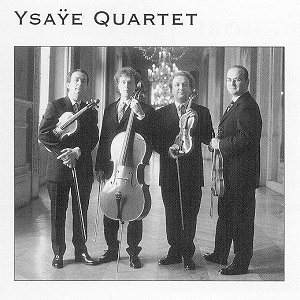S&H string quartet concert review:
YSAΫE QUARTET Franck Beethoven Bach Wigmore Hall 16 June 2002 (PGW)
César Franck's quartet in D major (1889) was performed in Paris to acclamation by EugeneYsaÿe and his own quartet in early 1890, and again at a reception in Franck's honour, after which the composer 'could die a happy man - which, six months later, he did' (Gerald Larner). Some fifty and more years ago I had shellac 78s of it, and the many side-breaks are noted in my Eulenberg miniature score. I had never heard it since then (and never at all live) but, such are the vagaries of elderly memory, it was like meeting a near-forgotten old friend, whose way of talking and familiar turns of phrase are fixed in the brain's deepest recesses. Yet it was an influential work, and it is suggested that those of Debussy & Ravel (which soon afterwards supplanted it in favour) would not have been composed without the Franck as a model. Unfailingly mellifluous, learnedly cyclic in its thematic development and structures, it proceeds in a leisurely manner for 50 minutes, though with a quicksilver Scherzo more like Mendelssohn. A very welcome re-acquaintance, and it does not deserve to languish in oblivion.
The Ysaÿe Quartet clearly has it in their bones and followed this with one of the finest performances of Beethoven's Op. 130 and the Op. 133 Grosse Fuge that I have ever encountered, making a mockery of Gerald Larner's endorsement in the programme notes of suggestions that the latter is better served by dozens of strings than four. Their tone was light and the brief central movements had a serenade-like quality, perfectly framing the Cavatina, given with a 'dead' tone in the beklemmt central section which 'almost chokes on its emotion - as eloquent as anything in opera' (Larner). Completely unfazed at the end of a strenuous programme, they made light of the difficulties of the Grosse Fuge and were able to clarify the textures without strain. Guillaume Sutre is a remarkable leader who never dominates unduly, and retains beautiful tone and perfect intonation up into the stratosphere. The first of Bach's Art of Fugue was a perfect help to come down to earth, suave and played practically without vibrato, just like period musicians.
Peter Grahame Woolf

 Return to:
Return to: